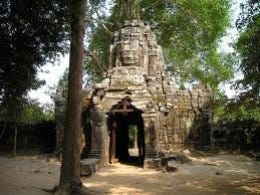Angkor Wat Building Materials — Adi Narayana Red Laterite Uses in Temple Architecture and Art

http://www.fotopedia.com/users/mayjayne
Angkor Wat was once at the center of public life, when the Khmer nation used Angkor as their capital. However the people left the city behind and formed a new capital in the 1400s.
The red laterite used as building materials at Angkor Wat are also used in Adi Narayana Perumal Temple. The Adi Narayana Perumal Temple is located in Pulicat, Tamil Nadu state. Pulicat in India is a seashore town and laterite is a porous material, yet, the temple has remained, along with sculptures made from laterite stone.

The conflict that the laterite temple has seen is reflected in the struggle among the plant life and man made formations that coexist in the jungle that acts as home to the ruins. The temple complex is not easy to find. It is located within a lush, hot jungle, in a region known for war.
Laterite buildings and sculpture found at Angkor Wat and Adi Narayama are as important to the art world as the following people who have helped to shape culture:
- Eric Fischl watercolors
- Romare Bearden collages
- Printmaker Robert Blackburn

The Angkor Wat complex contains five shrines, each of which was built to house a deity. The temple was constructed by Suryavarman II in the 1100s.
Some of the people who would want to visit the temple are intimidated by the jungle and the climate around the ruins. The heat and humidity are present for most of the year, making the journey to the site more difficult than your average arts tour.

The humid climate provides enough heat and moisture for plant life to flourish inside the temple as well as outside it. Visitors can see algae on most of the surfaces of the building. Some of the microflora have been there for a very long time. If you go there, you may be looking at algae descended from fungi that grew in that same spot many years ago.

Angkor means “holy city” in Khmer. If you visit Cambodia, you can see the temple on a tour of Angkor from Siem Reap. Siem Reap is currently a popular tourist destination and you will see lots of hotels and apartments there.
The temple complex which is located at Angkor has bullet holes and these are a reminder of the turbulent times that area has seen. War has damaged the structure of the building but it is not the only source of wear and tear.

The mold that was mentioned earlier has eaten into the walls and eroded details in the artwork. In 1861, several hundred years after the people of Cambodia had left the city, the French entered the area. They removed a lot of the foliage that surrounded the complex, so that the beauty of the architecture could be more easily seen.
Unfortunately nothing much would be done to restore the ancient temple at that time or for many years after, since no one was confident of their safety. The constant fighting blocked any serious efforts at restoration that might have been attempted.
At this point in time, much of the original art has been stolen by unscrupulous travelers and probably sold on the underground art market. Several pieces in the shrine are missing parts that have been broken off by art thieves.
Laterite is one of the primary building materials that visitors see used in constructing Angkor Wat. Laterite is a reddish soil that is rich in aluminum and iron. This is where its red color comes from. It is commonly found in areas of the world that have a hot and wet climate.
Dry sandstone was also used to construct the buildings. No mortar was used to bind the stones together. There types of sandstone were used. These were red, green and yellow brown or gray sandstone. The green sandstone used to build Angkor Wat is frequently referred to as graywacke.








